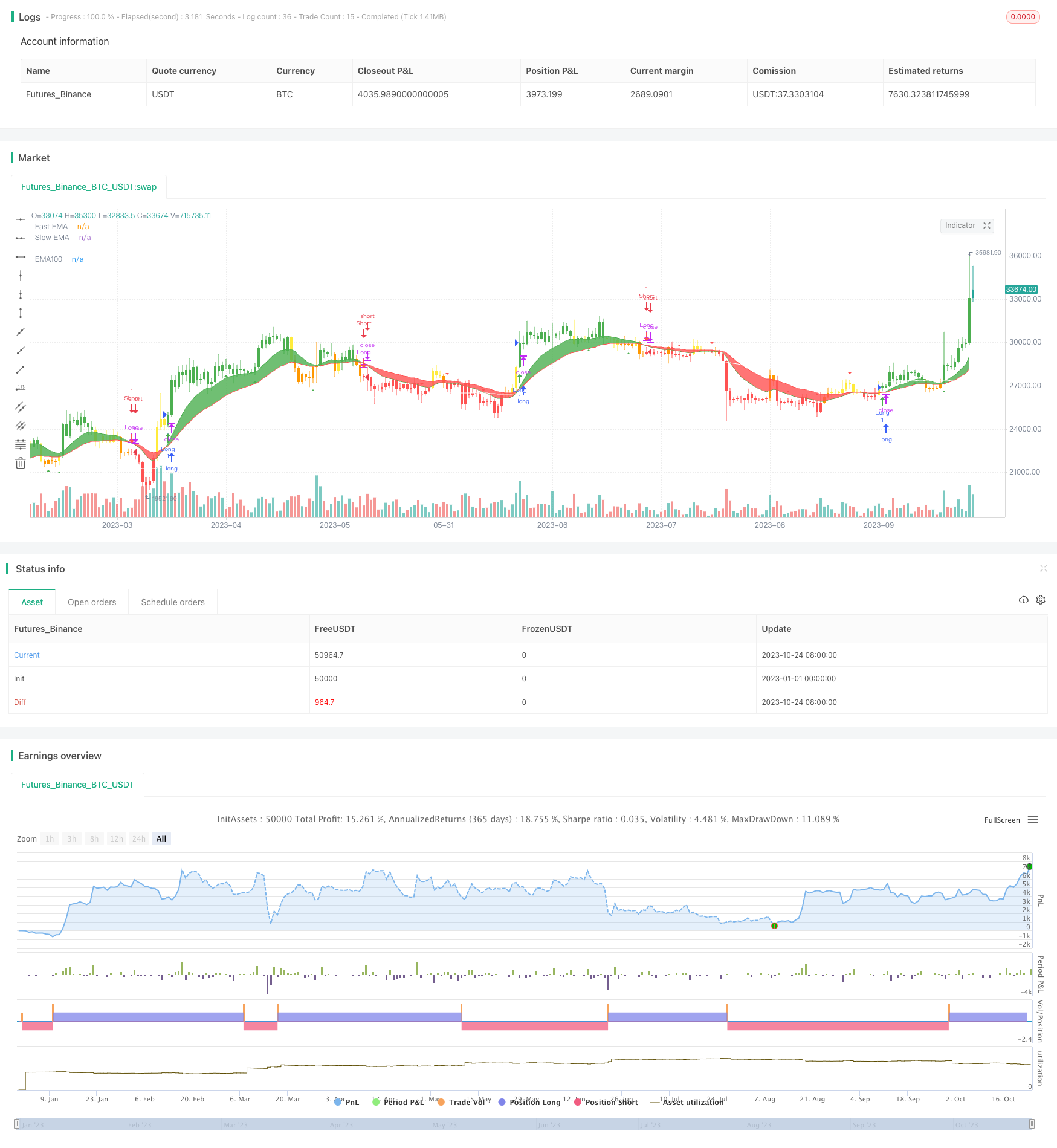
概述
双EMA黄绿交易系统是一种基于双指数移动平均线的趋势跟踪交易系统。该系统使用两条不同周期的EMA均线,根据价格与EMA均线的关系来判断目前的趋势方向并作出交易决策。该系统逻辑简单,容易操作,能很好地捕捉市场趋势,适合中长线投资者使用。
策略原理
该策略主要依赖两条EMA均线,分别是一条较快周期的EMA均线和一条较慢周期的EMA均线。当快EMA在慢EMA之上时,视为bullish;当快EMA在慢EMA之下时,视为bearish。
根据价格与两条EMA均线的关系,可以将K线分为不同的交易区域:
当快EMA在慢EMA上方,而价格在快EMA之上时(G1),为强势买入区域,此时可以买入。
当快EMA在慢EMA下方,而价格在快EMA之下时(R1),为强势卖出区域,此时可以卖出。
当快慢EMA交叉时,根据价格与两EMA的关系,可划分黄色(预警)和橙色(观望)区域。这两个区域代表趋势转折的可能,需要结合其他区域和其他指标来决定交易。
根据价格在不同交易区域的变化,该策略会发出买入和卖出信号。在强势区域G1和R1,策略会直接产生信号;在预警和观望区域,则需要其他指标确认。
此外,该策略还引入了StochRSI来辅助判断买卖时机。StochRSI的超买超卖情况可作为额外的买入卖出信号。
策略优势
策略逻辑简单清晰,容易理解和实现;
基于趋势运行,能够有效捕捉中长线趋势;
区分强势区域和违背趋势的预警/观望区域,交易信号比较可靠;
结合StochRSI,可以更准确判定买卖时机。
策略风险
纯趋势系统,在没有明确趋势的市场中交易效果可能不佳;
EMA周期设置不当可能导致虚假信号;
预警和观望区域交易风险较大,需要审慎对待;
未考虑止损导致亏损扩大的风险。
可以采用以下方法来降低风险:
选择有明显趋势的品种,在趋势较弱时暂停交易;
优化EMA周期参数,降低虚假信号概率;
在预警和观望区域引入其他指标进行确认,减少交易风险;
设置止损点,以控制单笔亏损。
策略优化方向
该策略可以从以下几个方面进行优化:
引入更多指标进行确认,如MACD、KDJ等,提高信号质量;
在交易区域引入过滤条件,如交易量放大,提高trades的成功率;
根据市场情况动态调整EMA参数,优化参数设定;
增加止损策略,在亏损达到一定比例时止损;
优化资金管理,设定合理的仓位管理;
在不同的品种上测试优化,寻找最佳参数组合。
通过引入更多辅助判断指标、动态参数优化、止损策略等提高系统稳定性,从资金管理等角度降低风险,该策略可以得到更好的交易效果。
总结
双EMA黄绿交易系统是一个基于双EMA均线比较的趋势跟踪交易系统。它区分不同的交易区域,根据价格与EMA均线关系判断趋势方向并产生交易信号,是一个逻辑清晰、易于实现的趋势跟踪系统。该策略有效捕捉趋势、交易规则简单直观等优点,但也存在一定风险。通过引入辅助指标、動态优化参数、设置止损以及优化资金管理等方式,可以降低风险并进一步提高系统的稳定性和盈利能力。总体来说,双EMA黄绿交易系统是一个非常适合中长线投资者使用的趋势跟踪系统。
/*backtest
start: 2023-01-01 00:00:00
end: 2023-10-25 00:00:00
period: 1d
basePeriod: 1h
exchanges: [{"eid":"Futures_Binance","currency":"BTC_USDT"}]
*/
// This source code is subject to the terms of the Mozilla Public License 2.0 at https://mozilla.org/MPL/2.0/
// © Vvaz_
//base-on CDC ActionZone By Piriya a simple 2EMA and is most suitable for use with medium volatility market
//@version=4
strategy(title="Vin's Playzone" ,shorttitle="VPz", overlay=true, margin_long=4, margin_short=2)
//variable
srcf = input(title="Source",type=input.source,defval=close)
tffix = input(title="Fixed Timeframe",type=input.bool,defval=true)
tfn = input(title="Timeframe in",type=input.resolution,defval="D")
ema1 = input(title="Fast EMA",type=input.integer,defval=12)
ema2 = input(title="Slow EMA",type=input.integer,defval=26)
ema3 = input(title="EMA 100",type=input.bool,defval=true)
smooter =input(title="Smoothing period (1 = no smoothing)",type=input.integer,defval=2)
fillbar =input(title="Fill Bar Color",type=input.bool,defval=true)
emasw = input(title="Show EMA",type=input.bool,defval=true)
bssw = input(title="Show Buy-Sell signal",type=input.bool,defval=true)
plotmm = input(title="Show Buy-Sell Momentum",type=input.bool,defval=true)
plotmmsm = input(title="RSI Smoothing",type=input.integer,defval=0,minval=0,maxval=2)
//math
xcross =ema(srcf,smooter)
efast = tffix ? ema(security(syminfo.tickerid,tfn,ema(srcf,ema1), gaps = barmerge.gaps_off,lookahead = barmerge.lookahead_on),smooter) :ema(xcross,ema1)
eslow = tffix ? ema(security(syminfo.tickerid,tfn,ema(srcf,ema2), gaps = barmerge.gaps_off,lookahead = barmerge.lookahead_on),smooter) :ema(xcross,ema2)
ema3x = ema(xcross,100)
//Zone
Bull = efast > eslow
Bear = efast < eslow
G1 = Bull and xcross > efast //buy
G2 = Bear and xcross > efast and xcross > eslow //pre-buy1
G3 = Bear and xcross > efast and xcross < eslow //pre-buy2
R1 = Bear and xcross < efast //sell
R2 = Bull and xcross < efast and xcross < eslow //pre-sell1
R3 = Bull and xcross < efast and xcross > eslow //pre-sell2
//color
bcl = G1 ? color.green : G2 ? color.yellow : G3 ? color.orange :R1 ? color.red :R2 ? color.orange : R3 ? color.yellow : color.black
barcolor(color=fillbar ? bcl : na )
//plots
line1 = plot(ema3 ? ema3x : na ,"EMA100",color=color.white)
line2 = plot(emasw ? efast : na ,"Fast EMA",color=color.green)
line3 = plot(emasw ? eslow : na ,"Slow EMA",color=color.red)
fillcl = Bull ? color.green : Bear ? color.red : color.black
fill(line2,line3,fillcl)
//actions
buywhen = G1 and G1[1]==0
sellwhen = R1 and R1[1]==0
bullish = barssince(buywhen) < barssince(sellwhen)
bearish = barssince(sellwhen) < barssince(buywhen)
buy = bearish[1] and buywhen
sell = bullish[1] and sellwhen
bullbearcl = bullish ? color.green : bearish ? color.red : color.black
//plot trend
plotshape(bssw ? buy : na ,style=shape.arrowup,title="BUY",location=location.belowbar,color=color.green)
plotshape( bssw ? sell : na ,style=shape.arrowdown ,title="Sell",location=location.abovebar,color=color.red)
// Momentum Signal using StochRSI
smoothK = input(5,"StochRSI smooth K",type=input.integer,minval=1)
smoothD = input(4,"StochRSI smooth D",type=input.integer,minval=1)
RSIlen = input(14,"RSI length",type=input.integer,minval=1)
STOlen = input(14,"Stochastic length",type=input.integer,minval=1)
SRsrc = input(close,"Source for StochasticRSI",type=input.source)
OSlel = input(20,"Oversold Threshold",type=input.float,minval=0.00)
OBlel = input(80,"Oversold Threshold",type=input.float,minval=0.00)
rsil = rsi(SRsrc,RSIlen)
K = sma(stoch(rsil,rsil,rsil,STOlen),smoothK)
D = sma(K,smoothD)
buymore = iff( bullish ,iff(D < OSlel and crossover(K,D), 2, iff(D > OSlel and crossover(K,D), 1,0)),0)
sellmore = iff( bearish,iff(D > OBlel and crossunder(K,D), 2, iff(D < OBlel and crossunder(K,D), 1,0)),0)
//plot momentum
plotshape(plotmm ? buymore > plotmmsm ? buymore : na : na ,"Buy More!" ,style=shape.triangleup,location=location.belowbar,color=color.green)
plotshape(plotmm ? sellmore > plotmmsm ? sellmore : na : na ,"Sell More!" ,style=shape.triangledown,location=location.abovebar,color=color.red)
// === INPUT BACKTEST RANGE ===
FromYear = input(defval = 2009, title = "From Year", minval = 2009)
FromMonth = input(defval = 1, title = "From Month", minval = 1, maxval = 12)
FromDay = input(defval = 1, title = "From Day", minval = 1, maxval = 31)
ToYear = input(defval = 9999, title = "To Year", minval = 2009)
ToMonth = input(defval = 12, title = "To Month", minval = 1, maxval = 12)
ToDay = input(defval = 31, title = "To Day", minval = 1, maxval = 31)
// === FUNCTION EXAMPLE ===
start = timestamp(FromYear, FromMonth, FromDay, 00, 00) // backtest start window
finish = timestamp(ToYear, ToMonth, ToDay, 23, 59) // backtest finish window
window() => time >= start and time <= finish ? true : false // create function "within window of time"
//stratgy excuter
strategy.entry("Long",true,when=window() and buy or buymore)
strategy.close("Long",when=window() and sell or sellmore,comment="TP Long")
strategy.entry("Short",false,when=window() and sell or sellmore)
strategy.close("Short",when=window() and buy or buymore,comment="TP Short")